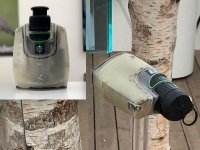In relation to rangefinder binoculars . . .
The point I was making in post #11 was about the problems of integrating electronics - that are by nature ephemeral - into what’s primarily a long lived optical package
I drew attention to Swarovski’s approach with the EL Range verses the approaches of Zeiss and Leica, as a possible indication of a way that might be taken with the Digital Guide
- - - -
More generally, while RF binoculars may be primarily intended for shooting and hunting activities, it does not follow that:
- shooters and hunters are the only users, and therefore
- others involved in outdoor activities, including birding, have no interest in them
A few examples . . .
A quick search picked up a 1998 article by the US Department of Agriculture and Forestry Service reviewing different rangefinders for Forrest Service use:
https://www.fs.fed.us/eng/pubs/html/98241307/98241307.html
(at the time rangefinder binocular were in their infancy, few in choice and prohibitively expensive, so the concentration was on monoculars)
And no doubt there are a wide variety of other outdoor occupational uses
Gijs van Ginkel has referred to using a RF binocular while in the field to help precisely focus a lens on a manual focus camera:
https://www.birdforum.net/showpost.php?p=3824612&postcount=71
SteveTS linked to dwever, who has on several occasions referred to his particular use of RF binoculars in Alaska
And while for some to go birding may be as simple as either:
- stepping out onto the back veranda, or
- walking from their transport to a viewing platform
that’s not the case for most
Particularly for those hiking into either new or difficult terrain, where birding may be part of the reason:
- the ability to both see ahead and to take into account distances in planning a route, can be invaluable
- and even more so as part of observing and remembering the path already taken, so as to be able to easily retrace the way out
Even using rangefinders in the field just to check your estimation of distances can be both revealing and educational
And finally, has no one birding ever wondered ‘Just how far away are those birds?'
- - - -
With binocular rangefinders as with other electronic products, there’s the constant pressure on manufacturers to update them, typically by either:
- increasing existing performance, and/ or
- adding new features
Part of the problem for Zeiss and Leica has been Swarovski’s clear optical superiority
(which seems to have been due the choice of an RF system that allowed outboard mounting of the bulk of it, thus enabling the superior optical performance)
So the logical non-optical response for Zeiss and Leica was to build on ballistic calculation capabilities. In their latest generations:
- Zeiss only offers binoculars with their latest ballistic options (it seems the idea being that if you don’t need the options, don’t use them), while
- Leica offers a choice of models with or without ballistic capabilities (though all models have the pressure and temperature sensors, which are intended to aid the ballistic functions enabled)
In relation to Leica's choices, for a manufacturer it’s more economic to build one circuit board with the full range of hardware and firmware, and enable different features to create a range of models
John







